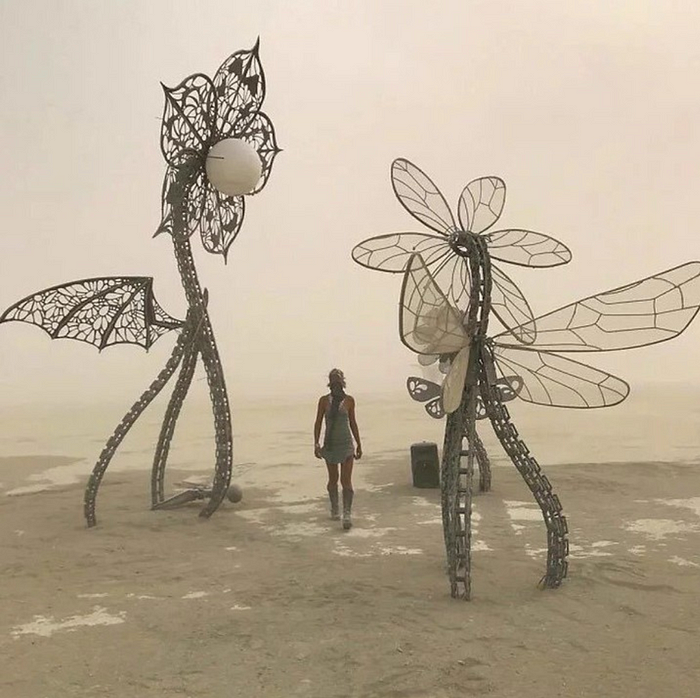
Where spiders, cobotics and plantoids come together: Reflections on Human-Machine Collaboration in a changing world workshop (HMC’22)
— Originally published on Australian National University’s School of Cybernetics blog
Often, when we think about the relationship between humans and machines (particularly machines of the future), we paint a picture of combat, of ‘evil machines’ that might replace us or worse, eradicate us all together. However, there is a whole other sphere of research emerging that looks at the human-machine relationship through the eyes of collaboration. On 1–2 December, I was really excited to travel to Paris and be a part of the Human Machine Collaboration in a changing world workshop (HMC22) as a presenter, chair of a panel and co-organiser.
Within the two-day workshop, HMC22 gathered together researchers and practitioners from all over the world and across many disciplines (including from sociology, computer science, design, governance, cybernetics, law, art and robotics) both in person in Paris and online to discuss questions like “What is human-machine collaboration from a multi-disciplinary perspective?” and “How might we address safety, sustainability and responsibility for systems involving human-machine collaboration?”
To give a sense of the breadth of insights shared, a few of my favourite sessions from the workshop are outlined below.
Hard Yards and Malleable Motions: realising cobotics — Alex Zafiroglu, ANU School of Cybernetics
Alex shared with us some of her preliminary ethnographic insights from observing, interviewing and working with members of the Australasian Dance Collective as they prepare for their upcoming project, Lucie in the Sky — where the dancers dance with drones. It was a fascinating insight into how the world of dance works and how it is transformed by including drones as part of the choreographic process. From a cybernetics perspective, it made me think a lot about the emergence of cybernetics in the 1940s where the Macy conferences used (what we would call now simple) models to discuss these relationships between human and machine. This investigation with the Australiasian Dance Collective provides new working examples to explore how a world where humans and cobots (robots that exist to collaborate with humans) co-exist may necessitate new languages to collaborate, and new ways of working and connecting.

Designing with Data: Human-Algorithm Collaboration in the Ultra-Fast Fashion Industry — Margot Hanley, Cornell Tech
Margot took us on a whirlwind tour of the potential roles of algorithms in the ultra-fast fashion industry, for example using social media to do real-time testing of particular design ideas that are then turned into fashion at super fast rates. She asks interesting questions on the role of creativity in human-machine collaboration processes associated with fashion and to what extent this creative work is done via algorithmic systems. Her research begins to debunk the hype around algorithms ‘taking over’ design, instead showing that creative professionals use inputs from a diverse array of sources, including those from an algorithm, as part of a wider creative process. For me, this talk brought back to ground the realities of working with algorithms in practice and began to debunk some of the myths around the sophistication and uptake of automation, particularly in the fashion industry.
Plantoids, a new blockchain based lifeform — Primavera De Fillipi (CNRS, Harvard, European University Institute)
In one of the most talked about sessions, Primavera De Fillipi shared her Plantoids — which are blockchain-based robots or synthetic organisms designed to look, act and grow like a plant. Exploration of this fascinating project revealed a myriad of questions regarding authorship and what Primavera referred to as ‘protocolism’ — the act of creating protocols that can then be taken up by others to mutate into new lifeforms. It made me think a lot about who is creating, implementing and moderating the protocols associated with the human-machine collaborations of the future.

A series of interactive art exhibits curated by Samuel Bianchini (École des Arts Décoratifs — PSL University) and Damith Herath (University of Canberra)
On both days, over an impressive canape lunch, we were immersed in amazing art exhibits and conversations with the artists. From robotic spiders moving based on physiological signals, to devices that move according to wifi signals detected, this was a truly wonderful part of the program and re-instilled a great love for art and design projects as ways in to imagining, demonstrating and interacting with the future. The featured projects included:
James Auger — Real Prediction Machines
Fabien Zocco — Spider and I
Raphaëlle Kerbrat — Bug Antenna
Melanie Lane and Damith Herath — Judy
Patrick Tresset — RNP-S Sketching study
Sarah Fdili Alaoui and Léa Paymal: Physicalizing Loops Scores
Hugo Scurto: The Co-Explorer
Yosra Mojtahedi: L’érosarbénus and Sexus Fleurus
Panel on responsibility in Human-Machine Collaboration
In addition to my own short talk exploring how we might centre dignity in the responsible design of human-machine collaborations, I was really fortunate to chair a panel on responsibility in human-machine collaboration (HMC). Together, we explored what it might take to really enact responsibility in practice when it comes to human-machine collaboration. Caitlin Bentley (Kings College London) raised questions regarding how to include people in the design of HMCs that have been traditionally excluded, drawing on her work in maritime systems. Dylan Cawthorne, a self-professed engineering activist from the University of Southern Denmark, discussed how he believes engineers can take on more responsibility than is ‘necessary’ and that we need to extend our views on what responsibility means to not just be about liability but also praiseworthiness. Keoni Mahelona from Te Hiku Media in New Zealand explained how data is treated as treasure in non-Western cultures — like friends, family and the environment — and respecting data sovereignty remains elusive in our current technology cultures of extraction. Jurriaan van Diggelen from TNO Soesterberg added insights regarding the human emotional part of an organisation, and thereby the role of emotions when it comes to HMCs as they become part of workplace cultures. A lively discussion on the points in the system that may enact the most change as well as where tradeoffs may emerge for decision-makers also ensued.
Overall, HMC22 was a great experience to connect on a deeper level with people working across disciplines and understand the emerging world of Human Machine Collaborations. This area of research is deeply intertwined with the School of Cybernetics’ mission to enable safe, sustainable and responsible futures.
HMC22 was a collaboration between ANU Centre for European Studies, ANU School of Cybernetics, ANU Fenner School of Environment and Society, University of Canberra, DIMACS at Rutgers University, CNRS LAMSADE, and EnsadLab, laboratory of the École nationale supérieure des Arts Décoratifs — PSL University. It was organised by Katherine Daniell (ANU), Joseph Guillaume (ANU), Damith Herath (University of Canberra), Fred Roberts (DIMACS), Alexis Tsoukiás (LAMSADE), Elizabeth Williams (ANU), Xuanying Zhu (ANU), Kathy Reid (ANU), Lorenn Ruster (ANU), Myrna Kennedy (ANU), Samuel Bianchini (EnsadLab), Sarra Tajouri (CNRS LAMSADE and Université Paris Dauphine-PSL) and Nicolas Fayard (CNRS LAMSADE and Université Paris Dauphine-PSL).
The Algorithmic Futures Policy Lab is made possible with the support of the Erasmus+ Programme of the European Union. The content in this post and any material herein reflects only the author’s view. The Education, Audiovisual and Culture Executive Agency and the European Commission are not responsible for any use that may be made of the information it contains. For more information, visit the Algorithmic Policy Lab website and subscribe to their fascinating podcast!
